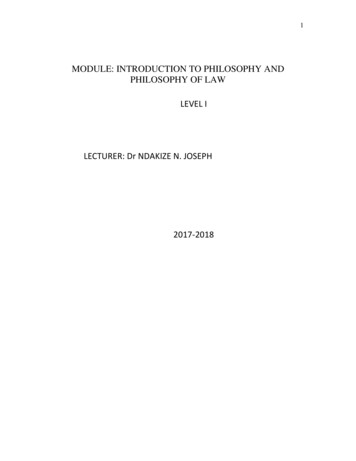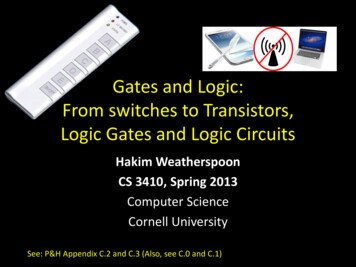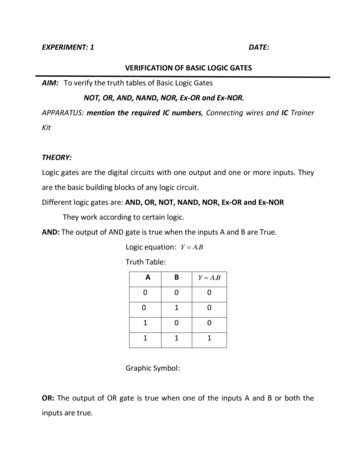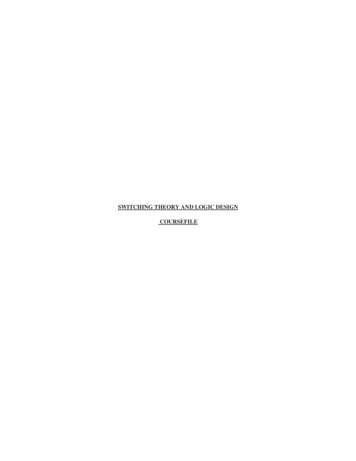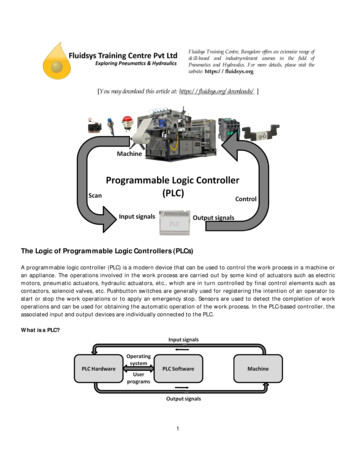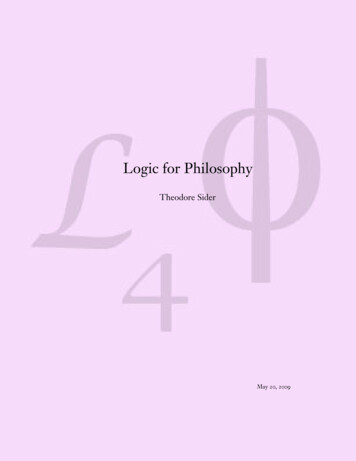
Transcription
Logic for PhilosophyTheodore SiderMay 20, 2009
PrefaceThis book is an introduction to logic for students of contemporary philosophy.It covers i) basic approaches to logic, including proof theory and especiallymodel theory, ii) extensions of standard logic (such as modal logic) that areimportant in philosophy, and iii) some elementary philosophy of logic. It prepares students to read the logically sophisticated articles in today’s philosophyjournals, and helps them resist bullying by symbol-mongerers. In short, itteaches the logic you need to know in order to be a contemporary philosopher.For better or for worse (I think better), the last century-or-so’s developmentsin logic are part of the shared knowledge base of philosophers, and inform nearlyevery area of philosophy. Logic is part of our shared language and inheritance.The standard philosophy curriculum therefore includes a healthy dose of logic.This is a good thing. But in many cases only a single advanced logic courseis required, which becomes the de facto sole exposure to advanced logic formany undergraduate philosophy majors and beginning graduate students. Andthis one course is often an intensive survey of metalogic (for example, onebased on the excellent Boolos et al. (2007).) I do believe in the value of such acourse, especially for students who take multiple logic courses or specialize in“technical” areas of philosophy. But for students taking only a single course, thatcourse should not, I think, be a course in metalogic. The standard metalogiccourse is too mathematically demanding for the average philosophy student,and omits material that the average student ought to know. If there can be onlyone, let it be a crash course in logic literacy.“Logic literacy” includes knowing what metalogic is all about. And you can’treally learn about anything in logic without getting your hands dirty and doingit. So this book does contain some metalogic (e.g., soundness and completenessproofs in propositional logic and propositional modal logic). But it doesn’tcover the central metalogical results one normally covers in a mathematicallogic course: soundness and completeness in predicate logic, computability,i
PREFACEiiGödel’s incompleteness theorems, and so on.I have decided to be very sloppy about use and mention. When such issuesmatter I draw attention to them; but where they do not I do not.Solutions to exercises marked with a single asterisk (*) are included inAppendix A. Exercises marked with a double asterisk (**) tend to be moredifficult, and have hints in Appendix A.I drew heavily from the following sources, which would be good for supplemental reading: Bencivenga (1986) (free logic); Boolos et al. (2007, chapter18) (metalogic, second-order logic); Cresswell (1990) (two-dimensional modallogic); Davies and Humberstone (1980) (two-dimensional modal logic); Gamut(1991a,b) (Descriptions, λ-abstraction, multi-valued, modal, and tense logic);Hilpinen (2001) (deontic logic); Hughes and Cresswell (1996) (modal logic—Iborrowed particularly heavily here—and tense logic); Kripke (1965) (intuitionistic logic); Lemmon (1965) (sequents in propositional logic); Lewis (1973a)(counterfactuals); Mendelson (1987) (propositional and predicate logic, metalogic); Meyer (2001) (epistemic logic); Priest (2001) (intuitionistic and paraconsistent logic); Stalnaker (1977) (λ-abstraction); Westerståhl (1989) (generalizedquantifiers).Another important source, particularly for chapters 6 and 8, was Ed Gettier’s1988 modal logic class at the University of Massachusetts. The first incarnationof this work grew out of my notes from this course. I am grateful to Ed for hiswonderful class, and for getting me interested in logic.I am also deeply grateful for feedback from many students, colleagues,and referees. In particular, Marcello Antosh, Josh Armstrong, Dean Chapman, Tony Dardis, Justin Clarke-Doane, Mihailis Diamantis, Mike Fara, GabeGreenberg, Angela Harper, John Hawthorne, Paul Hovda, Phil Kremer, SamiLaine, Gregory Lavers, Brandon Look, Stephen McLeod, Kevin Moore, Alex6 gaard, Nick Riggle, Jeff Russell, Brock Sides, JaMorgan, Tore Fjetland Oson Turner, Crystal Tychonievich, Jennifer Wang, Brian Weatherson, EvanWilliams, Xing Taotao, Seth Yalcin, Zanja Yudell, Richard Zach, and especiallyAgustín Rayo: thank you.
ContentsPreface12iWhat is Logic?1.1 Logical consequence and logical truth1.2 Formalization . . . . . . . . . . . . . . . . .1.3 Metalogic . . . . . . . . . . . . . . . . . . .Exercises 1.1–1.2 . . . . . . . . . . . . . . .1.4 Application . . . . . . . . . . . . . . . . . .1.5 The nature of logical consequence . . .Exercise 1.3 . . . . . . . . . . . . . . . . . . .1.6 Logical constants . . . . . . . . . . . . . .1.7 Extensions, deviations, variations . . . .1.8 Set theory . . . . . . . . . . . . . . . . . . .Exercises 1.4–1.5 . . . . . . . . . . . . . . .12348891112141529Propositional Logic2.1 Grammar of PL . . . . . . . . . . . . . . . .2.2 The semantic approach to logic . . . . . .2.3 Semantics of propositional logic . . . . .Exercise 2.1 . . . . . . . . . . . . . . . . . . . .2.4 Validity and invalidity in PL . . . . . . . .Exercise 2.2 . . . . . . . . . . . . . . . . . . . .2.4.1 Schemas, validity, and invalidity2.5 Sequent proofs in PL . . . . . . . . . . . . .2.5.1 Sequents . . . . . . . . . . . . . . .2.5.2 Rules . . . . . . . . . . . . . . . . . .2.5.3 Sequent proofs . . . . . . . . . . .2.5.4 Example sequent proofs . . . . .Exercise 2.3 . . . . . . . . . . . . . .3030343542434445464750525457iii
CONTENTS2.62.72.82.934Axiomatic proofs in PL . . . . . . . . . . . . . .Exercise 2.4 . . . . . . . . . . . . . . . . . . . . . . .Soundness of PL and proof by induction . . .Exercises 2.5–2.10 . . . . . . . . . . . . . . . . . .PL proofs and the deduction theorem . . . .Exercises 2.11–2.12 . . . . . . . . . . . . . . . . . .Completeness of PL . . . . . . . . . . . . . . . .2.9.1 Maximal consistent sets of wffs . . .2.9.2 Maximal consistent extensions . . . .2.9.3 Features of maximal consistent sets .2.9.4 The proof . . . . . . . . . . . . . . . . .iv.Beyond Standard Propositional Logic3.1 Alternate connectives . . . . . . . . . . . . . . . . . . . . . . . . . .3.1.1 Symbolizing truth functions in propositional logic3.1.2 Sheffer stroke . . . . . . . . . . . . . . . . . . . . . . . . .3.1.3 Inadequate connective sets . . . . . . . . . . . . . . . .Exercises 3.1–3.3 . . . . . . . . . . . . . . . . . . . . . . .3.2 Polish notation . . . . . . . . . . . . . . . . . . . . . . . . . . . . . .Exercise 3.4 . . . . . . . . . . . . . . . . . . . . . . . . . . . . . . . . .3.3 Nonclassical propositional logics . . . . . . . . . . . . . . . . . .3.4 Three-valued logic . . . . . . . . . . . . . . . . . . . . . . . . . . .3.4.1 Łukasiewicz’s system . . . . . . . . . . . . . . . . . . . .Exercises 3.5–3.6 . . . . . . . . . . . . . . . . . . . . . . .3.4.2 Kleene’s tables . . . . . . . . . . . . . . . . . . . . . . . .Exercises 3.7–3.9 . . . . . . . . . . . . . . . . . . . . . . .3.4.3 Determinacy . . . . . . . . . . . . . . . . . . . . . . . . . .3.4.4 Priest’s logic of paradox . . . . . . . . . . . . . . . . . .Exercises 3.10–3.11 . . . . . . . . . . . . . . . . . . . . . .3.4.5 Supervaluationism . . . . . . . . . . . . . . . . . . . . . .Exercises 3.12–3.16 . . . . . . . . . . . . . . . . . . . . . .3.5 Intuitionistic propositional logic: proof theory . . . . . . . . .Exercise 3.17 . . . . . . . . . . . . . . . . . . . . . . . . . . . . . . . 100100102104104110110114Predicate Logic1154.1 Grammar of predicate logic . . . . . . . . . . . . . . . . . . . . . . 1154.2 Semantics of predicate logic . . . . . . . . . . . . . . . . . . . . . . 117Exercise 4.1 . . . . . . . . . . . . . . . . . . . . . . . . . . . . . . . . . . 122
CONTENTS4.34.44.55Establishing validity and invalidityExercises 4.2–4.3 . . . . . . . . . . . .Axiomatic proofs in PC . . . . . . .Exercise 4.4 . . . . . . . . . . . . . . . .Metalogic of PC . . . . . . . . . . . .Exercise 4.5 . . . . . . . . . . . . . . . .v.Beyond Standard Predicate Logic5.1 Identity . . . . . . . . . . . . . . . . . . . . . . . . . . . . . . . . . .5.1.1 Grammar for the identity sign . . . . . . . . . . . . .5.1.2 Semantics for the identity sign . . . . . . . . . . . . .5.1.3 Symbolizations with the identity sign . . . . . . . .Exercises 5.1–5.2 . . . . . . . . . . . . . . . . . . . . . .5.2 Function symbols . . . . . . . . . . . . . . . . . . . . . . . . . . .Exercise 5.3 . . . . . . . . . . . . . . . . . . . . . . . . . . . . . . . .5.2.1 Grammar for function symbols . . . . . . . . . . . .5.2.2 Semantics for function symbols . . . . . . . . . . . .Exercise 5.4 . . . . . . . . . . . . . . . . . . . . . . . . . .5.3 Definite descriptions . . . . . . . . . . . . . . . . . . . . . . . . .5.3.1 Grammar for ι . . . . . . . . . . . . . . . . . . . . . . .5.3.2 Semantics for ι . . . . . . . . . . . . . . . . . . . . . . .Exercises 5.5–5.6 . . . . . . . . . . . . . . . . . . . . . .5.3.3 Elimination of function symbols and descriptionsExercises 5.7–5.8 . . . . . . . . . . . . . . . . . . . . . .5.4 Further quantifiers . . . . . . . . . . . . . . . . . . . . . . . . . .5.4.1 Generalized monadic quantifiers . . . . . . . . . . .Exercise 5.9 . . . . . . . . . . . . . . . . . . . . . . . . . .5.4.2 Generalized binary quantifiers . . . . . . . . . . . . .Exercise 5.10 . . . . . . . . . . . . . . . . . . . . . . . . .5.4.3 Second-order logic . . . . . . . . . . . . . . . . . . . .Exercise 5.11 . . . . . . . . . . . . . . . . . . . . . . . . .5.5 Complex Predicates . . . . . . . . . . . . . . . . . . . . . . . . . .Exercises 5.12–5.13 . . . . . . . . . . . . . . . . . . . . . . . . . . .5.6 Free Logic . . . . . . . . . . . . . . . . . . . . . . . . . . . . . . . .5.6.1 Semantics for free logic . . . . . . . . . . . . . . . . .Exercises 5.14–5.15 . . . . . . . . . . . . . . . . . . . . .5.6.2 Proof theory for free logic . . . . . . . . . . . . . . 5166169169
CONTENTS6Propositional Modal Logic6.1 Grammar of MPL . . . . . . . . . . . . . . . . . . . . . . . . . .6.2 Symbolizations in MPL . . . . . . . . . . . . . . . . . . . . . .6.3 Semantics for MPL . . . . . . . . . . . . . . . . . . . . . . . . .6.3.1 Kripke models . . . . . . . . . . . . . . . . . . . . . .Exercise 6.1 . . . . . . . . . . . . . . . . . . . . . . . . .6.3.2 Semantic validity proofs . . . . . . . . . . . . . . . .Exercise 6.2 . . . . . . . . . . . . . . . . . . . . . . . . .6.3.3 Countermodels . . . . . . . . . . . . . . . . . . . . . .Exercise 6.3 . . . . . . . . . . . . . . . . . . . . . . . . .6.4 Axiomatic systems of MPL . . . . . . . . . . . . . . . . . . . .6.4.1 System K . . . . . . . . . . . . . . . . . . . . . . . . . .Exercises 6.4–6.5 . . . . . . . . . . . . . . . . . . . . .6.4.2 System D . . . . . . . . . . . . . . . . . . . . . . . . . .Exercise 6.6 . . . . . . . . . . . . . . . . . . . . . . . . .6.4.3 System T . . . . . . . . . . . . . . . . . . . . . . . . . .Exercise 6.7 . . . . . . . . . . . . . . . . . . . . . . . . .6.4.4 System B . . . . . . . . . . . . . . . . . . . . . . . . . .Exercise 6.8 . . . . . . . . . . . . . . . . . . . . . . . . .6.4.5 System S4 . . . . . . . . . . . . . . . . . . . . . . . . .Exercise 6.9 . . . . . . . . . . . . . . . . . . . . . . . . .6.4.6 System S5 . . . . . . . . . . . . . . . . . . . . . . . . .Exercise 6.10 . . . . . . . . . . . . . . . . . . . . . . . .6.4.7 Substitution of equivalents and modal reductionExercise 6.11 . . . . . . . . . . . . . . . . . . . . . . . .6.5 Soundness in MPL . . . . . . . . . . . . . . . . . . . . . . . . .Exercises 6.12–6.13 . . . . . . . . . . . . . . . . . . . . . . . . . .6.5.1 Soundness of K . . . . . . . . . . . . . . . . . . . . . .6.5.2 Soundness of T . . . . . . . . . . . . . . . . . . . . . .6.5.3 Soundness of B . . . . . . . . . . . . . . . . . . . . . .Exercises 6.14–6.15 . . . . . . . . . . . . . . . . . . . .6.6 Completeness in MPL . . . . . . . . . . . . . . . . . . . . . . .6.6.1 Definition of canonical models . . . . . . . . . . .6.6.2 Facts about maximal consistent sets . . . . . . . .Exercise 6.16 . . . . . . . . . . . . . . . . . . . . . . . .6.6.3 “Mesh” . . . . . . . . . . . . . . . . . . . . . . . . . . .Exercise 6.17 . . . . . . . . . . . . . . . . . . . . . . . .6.6.4 Truth and membership in canonical models . . 226227229229231231
CONTENTS6.6.578viiCompleteness of systems of MPL . . . . . . . . . . . . . 232Exercises 6.18–6.20 . . . . . . . . . . . . . . . . . . . . . . . 233Beyond Standard MPL7.1 Deontic logic . . . . . . . . . . . . . . . . . . . . . .Exercises 7.1–7.2 . . . . . . . . . . . . . . . . . . . .7.2 Epistemic logic . . . . . . . . . . . . . . . . . . . . .Exercise 7.3 . . . . . . . . . . . . . . . . . . . . . . . .7.3 Propositional tense logic . . . . . . . . . . . . . .7.3.1 The metaphysics of time . . . . . . . . .7.3.2 Tense operators . . . . . . . . . . . . . . .7.3.3 Kripke-style semantics for tense logicExercises 7.4–7.5 . . . . . . . . . . . . . .7.3.4 Formal constraints on . . . . . . . . .Exercise 7.6 . . . . . . . . . . . . . . . . . .7.4 Intuitionistic propositional logic: semantics . .7.4.1 Proof stages . . . . . . . . . . . . . . . . .Exercises 7.7–7.8 . . . . . . . . . . . . . .7.4.2 Examples . . . . . . . . . . . . . . . . . . .Exercises 7.9–7.10 . . . . . . . . . . . . . .7.4.3 Soundness . . . . . . . . . . . . . . . . . .Exercises 7.11–7.13 . . . . . . . . . . . . .Counterfactuals8.1 Natural language counterfactuals . . . .8.1.1 Antecedents and consequents8.1.2 Can be contingent . . . . . . . .8.1.3 No augmentation . . . . . . . .8.1.4 No contraposition . . . . . . . .8.1.5 Some implications . . . . . . . .8.1.6 Context dependence . . . . . .8.2 The Lewis/Stalnaker theory . . . . . . .8.3 Stalnaker’s system (SC) . . . . . . . . . .8.3.1 Syntax of SC . . . . . . . . . . . .8.3.2 Semantics of SC . . . . . . . . .Exercise 8.1 . . . . . . . . . . . . .8.4 Validity proofs in SC . . . . . . . . . . . .Exercise 8.2 . . . . . . . . . . . . . . . . . . 4265
CONTENTS8.58.68.78.88.99Countermodels in SC . . . . . . . . . . . .Exercises 8.3–8.4 . . . . . . . . . . . . . . . .Logical Features of SC . . . . . . . . . . .8.6.1 No exportation . . . . . . . . . . .8.6.2 No importation . . . . . . . . . . .8.6.3 No transitivity . . . . . . . . . . .8.6.4 No transposition . . . . . . . . . .Lewis’s criticisms of Stalnaker’s theory .Lewis’s system . . . . . . . . . . . . . . . . .Exercises 8.5–8.6 . . . . . . . . . . . . . . . .The problem of disjunctive antecedentsviii.Quantified Modal Logic9.1 Grammar of QML . . . . . . . . . . . . . . . . . . .9.2 De re and de dicto . . . . . . . . . . . . . . . . . . . .9.3 A simple semantics for QML . . . . . . . . . . . .9.4 Countermodels and validity proofs in SQML .Exercise 9.1 . . . . . . . . . . . . . . . . . . . . . . . . .9.5 Philosophical questions about SQML . . . . . . .9.5.1 The necessity of identity . . . . . . . . . .9.5.2 The necessity of existence . . . . . . . . .Exercise 9.2 . . . . . . . . . . . . . . . . . . .9.5.3 Necessary existence defended . . . . . .9.6 Variable domains . . . . . . . . . . . . . . . . . . . .9.6.1 Contingent existence vindicated . . . . .Exercises 9.3–9.4 . . . . . . . . . . . . . . .9.6.2 Increasing, decreasing domains . . . . .Exercise 9.5 . . . . . . . . . . . . . . . . . . .9.6.3 Strong and weak necessity . . . . . . . . .9.6.4 Actualist and possibilist quantification .9.7 Axioms for SQML . . . . . . . . . . . . . . . . . . .Exercise 9.6 . . . . . . . . . . . . . . . . . . . . . . . . .10 Two-dimensional modal logic10.1 Actuality . . . . . . . . . . . . . . . . . . . . . . . . . .10.1.1 Kripke models with designated worldsExercise 10.1 . . . . . . . . . . . . . . . . . .10.1.2 Semantics for @ . . . . . . . . . . . . . . 19320321321
CONTENTS10.1.3 Establishing validity and invalidity10.2 . . . . . . . . . . . . . . . . . . . . . . . . . . . .10.2.1 Two-dimensional semantics for .Exercise 10.2 . . . . . . . . . . . . . . .10.3 Fixedly . . . . . . . . . . . . . . . . . . . . . . . .Exercises 10.3–10.5 . . . . . . . . . . . . . . . . .10.4 Necessity and a priority . . . . . . . . . . . . .Exercises 10.6–10.9 . . . . . . . . . . . . . . . . .AAnswers and dex359
Chapter 1What is Logic?ince you are reading this book, you probably know some logic already.You probably know how to translate English sentences into symbolicnotation, into propositional logic:SEnglishPropositional logicEither violets are blue or I need glasses V NIf snow is white then grass is not green S Gand into predicate logic:EnglishIf Grant is male then someone is maleAny friend of Barry is either insane orfriends with everyonePredicate logicM g xM x x[F x b (I x yF xy)]You are probably also familiar with some techniques for evaluating argumentswritten out in symbolic notation. You have probably encountered truth tables,and some form of proof theory (perhaps a “natural deduction” system; perhaps“truth trees”.) You may have even encountered some elementary model theory.In short: you have taken an introductory course in symbolic logic.What you already possess is: literacy in elementary logic. What you willget out of this book is: literacy in the rest of logic that philosophers tend topresuppose, plus a deeper grasp of what logic is all about.So what is logic all about?1
CHAPTER 1. WHAT IS LOGIC?21.1 Logical consequence and logical truthLogic is about many things, but most centrally it is about logical consequence. Thestatement “someone is male” is a logical consequence of the statement “Grant ismale”. If Grant is male, then it logically follows that someone is male. Put anotherway: the statement “Grant is male” logically implies the statement “someoneis male”. Likewise, the statement “Grant is male” is a logical consequence ofthe statements “It’s not the case that Leisel is male” and “Either Leisel is maleor Grant is male” (taken together). The first statement follows from the lattertwo statements; they logically imply it. Put another way: the argument whosepremises are the latter two statements, and whose conclusion is the formerstatement, is a logically correct one.1So far we’ve just given synonyms. The following slogan advances us a bitfurther: logical consequence is truth-preservation by virtue of form. To unpack abit: for φ to be a logical consequence of ψ, it is not enough that we all knowthat φ is true if ψ is. We all know that an apple will fall if it is dropped, butthe relationship between falling and dropping does not hold by virtue of logic.Why not? For one thing, “by virtue of logic” requires the presence of some sortof necessary connection, a connection that is absent in the case of the droppedapple (since it would be possible—in some sense—for a dropped apple not tofall). For another, it requires the relationship to hold by virtue of the formsof the statements involved, whereas the relationship between “the apple wasdropped” and “the apple fell” holds by virtue of the contents of these statementsand not their form. (By contrast, the inference from ‘It’s not the case that Leiselis male” and “Either Leisel is male or Grant is male” to “Grant is male” is saidto hold in virtue of form, since any argument of the form “it’s not the case thatφ; either φ or ψ; therefore ψ” is logically correct.) As we’ll see shortly, thereare many open philosophical questions in this vicinity, but perhaps we haveenough of an intuitive fix on the concept of logical consequence to go on with,at least for the moment.A related concept is that of a logical truth. Just as logical consequence istruth-preservation by virtue of form, logical truth is truth by virtue of form.Examples might include: “it’s not the case that snow is white and also notwhite”, “All fish are fish”, and “If Grant is male then someone is male”. As withlogical consequence, logical truth is thought to require some sort of necessity1The word ‘valid’ is sometimes used for logically correct arguments, but I will reserve thatword for a different concept: that of a logical truth, under the semantic conception.
CHAPTER 1. WHAT IS LOGIC?3and to hold by virtue of form, not content. It is plausible that logical truthand logical consequence are related thus: a logical truth is a sentence that is alogical consequence of the empty set of premises. One can infer a logical truthby using logic alone, without the help of any premises.A central goal of logic, then, is to study logical truth and logical consequence.But the contemporary method for doing so is somewhat indirect. As we willsee in the next section, instead of formulating claims about logical consequenceand logical truth themselves, modern logicians develop formal models of howthose concepts behave.1.2 FormalizationModern logic is called “mathematical” or “symbolic” logic, because its methodis the mathematical study of formal languages. Modern logicians use the toolsof mathematics (especially, the tools of very abstract mathematics, such as settheory) to treat sentences and other parts of language as mathematical objects.They define up formal languages, define up sentences of the languages, defineup properties of the sentences, and study those properties. Mathematical logicwas originally developed to study mathematical reasoning, but its techniquesare now applied to reasoning of all kinds.Take propositional logic, the topic of chapter 2. Here our goal is to shedlight on the logical behavior of ‘and’, ‘or’, and so on. But rather than studyingthose words directly, we will develop a certain formal language, the languageof propositional logic. The sentences of this language look like this:P(Q R) (Q S)P (P Q)Symbols like and represent natural language logical words like ‘and’ and‘or’; and the sentence letters P, Q, . . . represent declarative natural languagesentences. We will then go on to define (as always, in a mathematically rigorousway) various concepts that apply to the sentences in this formal language. Wewill define the notion of a tautology (“all Trues in the truth table”), for example,and the notion of a provable formula (we will do this using a system of deductionwith rules of inference; but one could use truth trees, or some other method).These defined concepts are “formalized versions” of the concepts of logicalconsequence and logical truth.
CHAPTER 1. WHAT IS LOGIC?4Formalized logical consequence and logical truth should be distinguishedfrom the real things. The formal sentence P P is a tautology, but since it isuninterpreted, we probably shouldn’t call it a logical truth. Rather, it representslogical truths like “If snow is white then snow is white”. A logical truth oughtat least to be true, after all, and P P isn’t true, since it doesn’t even havea meaning—what’s the meaning of P ? (Caveat: one might give meanings toformal sentences—by translation into natural language (“let P mean that snowis white; let mean and ”), or perhaps by some direct method if no naturallanguage translation is available. And we may indeed speak of logical truth andlogical consequence for interpreted formal sentences.)Why are formal languages called “formal”? (They’re also sometimes called“artificial” languages.) Because their properties are mathematically stipulated,rather than being pre-existent in flesh-and-blood linguistic populations. Westipulatively define a formal language’s grammar. (Natural languages like English also have grammars, which can be studied using mathematical techniques.But these grammars are much more complicated, and are discovered rather thanstipulated.) And we must stipulatively define any properties of the symbolicsentences that we want to study, for example, the property of being a tautology.(Sentences of natural languages already have meanings, truth values, and soon; we don’t get to stipulate these.) Further, formal languages often containabstractions, like the sentence letters P, Q, . . . of propositional logic. A givenformal language is designed to represent the logical behavior of a select fewnatural language words; when we use it we abstract away from all other featuresof natural language sentences. Propositional logic, for example, represents thelogical behavior of ‘and’, ‘or’, and a few other words. When a sentence containsnone of these words of interest, we represent it with one of the sentence lettersP, Q, . . . , indicating that we are ignoring its internal structure.1.3 MetalogicThere are many reasons to formalize—to clarify meaning, to speak moreconcisely, and so on. But one of the most powerful reasons is to do metalogic.In introductory logic one learns to use certain logical systems—how toconstruct truth tables, derivations and truth trees, and the rest. But logiciansdo not develop systems only to sit around all day using them. As soon as alogician develops a new system, she begins to ask questions about that system.For an analogy, imagine people who make up new games for a living. If they
CHAPTER 1. WHAT IS LOGIC?5invent a new version of chess, they might spend some time actually playingit. But if they are like logicians, they will quickly tire of this and start askingquestions about the game. “Is the average length of this new game longer thanthe average length of a game of standard chess?”. “Is there any strategy thatguarantees victory?” Analogously, logicians ask questions about logical systems.“What formulas can be proven in such and such a system?” “Can you provethe same things in this system as in system X?” “Can a computer program bewritten to determine whether a given formula is provable in this system?” Thestudy of such questions about formal systems is called “metalogic”.The best way to definitively answer metalogical questions is to use themethods of mathematics. And to use the methods of mathematics, we needto have rigorous definitions of the crucial terms that are in play. For example,in chapter 2 we will mathematically demonstrate that “every formula that isprovable (in a certain formal system) is a tautology”. But doing so requirescarefully defining the crucial terms: ‘formula’, ‘provable’, and ‘tautology’; andthe best way to do this is to formalize. We treat the languages of logic asmathematical objects so that we can mathematically demonstrate facts aboutthem.Metalogic is a fascinating and complex subject; and other things beingequal, it’s good to know as much about it as you can. Now, other things arerarely equal; and the premise of this book is that if push sadly comes to shove,limited classroom time should be devoted to achieving logic literacy ratherthan a full study of metalogic in all its glory. But still, logic literacy does requireunderstanding metalogic: understanding what it is, what it accomplishes, andhow one goes about doing it. So we will be doing a decent amount of metalogicin this book. But not too much, and not the harder bits.Much of metalogic consists of proving things about formal systems. Andsometimes, those formal systems themselves concern proof. For example, as Isaid a moment ago, we will prove in chapter 2 that every provable formula is atautology. If this seems dizzying, keep in mind that ‘proof’ here is being usedin two different senses. There are metalogic proofs, and there are proofs in formalsystems. Metalogic proofs are phrased in natural language (perhaps augmentedwith mathematical vocabulary), and employ informal (though rigorous!) reasoning of the sort one would encounter in a mathematics book. The chapter 2argument that “every provable formula is a tautology” will be a metalogic proof.Proofs in formal systems, on the other hand, are phrased using sentences offormal languages, and proceed according to prescribed formal rules. ‘Provable’in the statement ‘every provable formula is a tautology’ signifies proof in a
C
This book is an introduction to logic for students of contemporary philosophy. It covers i) basic approaches to logic, including proof theory and especially model theory, ii) extensions of standard logic (such as modal logic) that are important in philosophy, and iii) some elementary

